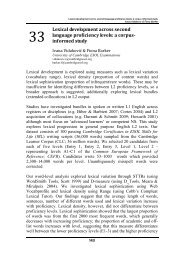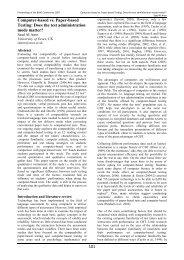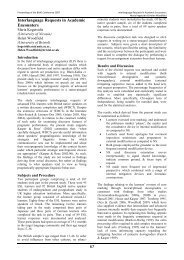The actuality adverbs in fact, actually, really and indeed - British ...
The actuality adverbs in fact, actually, really and indeed - British ...
The actuality adverbs in fact, actually, really and indeed - British ...
You also want an ePaper? Increase the reach of your titles
YUMPU automatically turns print PDFs into web optimized ePapers that Google loves.
Proceed<strong>in</strong>gs of the BAAL Conference 2007 <strong>The</strong> <strong>actuality</strong> <strong>adverbs</strong> <strong>in</strong> <strong>fact</strong>, <strong>actually</strong>, <strong>really</strong> <strong>and</strong> <strong>in</strong>deed- establish<strong>in</strong>g similarities <strong>and</strong> differences<br />
Kar<strong>in</strong> Aijmer<br />
writ<strong>in</strong>g <strong>and</strong> <strong>really</strong> was seven times as frequent <strong>in</strong><br />
speech as <strong>in</strong> writ<strong>in</strong>g. On the other h<strong>and</strong>, <strong>in</strong>deed was<br />
only four times as frequent <strong>in</strong> speech as <strong>in</strong> writ<strong>in</strong>g<br />
which is similar to the distribution of <strong>in</strong> <strong>fact</strong>. <strong>The</strong> high<br />
frequency <strong>in</strong> spoken language does not mean that the<br />
<strong>adverbs</strong> are frequent <strong>in</strong> conversation only but we need<br />
to consider a number of different categories of spoken<br />
English. It is important to also consider where they<br />
occur <strong>in</strong> written text types.<br />
We know from earlier studies that the <strong>adverbs</strong> can vary<br />
their mean<strong>in</strong>g depend<strong>in</strong>g on text type. Thus Biber <strong>and</strong><br />
F<strong>in</strong>egan (1989) have <strong>in</strong>vestigated stance markers<br />
(expressions of „attitudes, feel<strong>in</strong>gs, judgments <strong>and</strong><br />
commitment concern<strong>in</strong>g the propositional content of a<br />
message‟) <strong>in</strong> different text types. <strong>The</strong>y identified the<br />
stance markers <strong>in</strong> the LOB <strong>and</strong> the LLC corpora on the<br />
basis of their frequencies <strong>in</strong> the corpora <strong>and</strong> sorted<br />
them <strong>in</strong>to clusters represent<strong>in</strong>g different stance styles<br />
based on the common situational characteristics of the<br />
cooccurr<strong>in</strong>g text types <strong>in</strong> speech <strong>and</strong> writ<strong>in</strong>g. Certa<strong>in</strong>ty<br />
<strong>adverbs</strong> (which <strong>in</strong>clude the <strong>adverbs</strong> discussed <strong>in</strong> this<br />
paper) were for <strong>in</strong>stance frequent <strong>in</strong> the cluster<br />
„<strong>in</strong>teractional evidentiality‟: an „<strong>in</strong>volved<br />
conversational style‟ characteristically made up of<br />
face-to-face conversation <strong>and</strong> telephone conversation<br />
(<strong>and</strong> a spr<strong>in</strong>kl<strong>in</strong>g of other texts such as public<br />
conversations, personal letters, radio broadcast,<br />
academic prose). <strong>The</strong> <strong>adverbs</strong> were however also<br />
frequent <strong>in</strong> the cluster „oral conversational persuasion‟<br />
where the majority of texts were spontaneous speeches,<br />
<strong>in</strong>terviews, public conversations <strong>and</strong> romance fiction<br />
<strong>and</strong> characterised as „<strong>in</strong>formational discourse where<br />
there is a certa<strong>in</strong> amount of controversy or<br />
disagreement concern<strong>in</strong>g the topic of discussion‟<br />
(Biber <strong>and</strong> F<strong>in</strong>egan 1989: 115).<br />
<strong>The</strong> ICE-GB Corpus allows an even more f<strong>in</strong>e-gra<strong>in</strong>ed<br />
analysis of the <strong>adverbs</strong> on the basis of a large types of<br />
spoken <strong>and</strong> written texts. We can for <strong>in</strong>stance study the<br />
use of the <strong>adverbs</strong> is public dialogues such as<br />
classroom lessons, parliamentary debates <strong>and</strong> legal<br />
cross-exam<strong>in</strong>ations <strong>and</strong> make comparisons with<br />
unscripted monologues such as speeches. <strong>The</strong> written<br />
texts range from professional writ<strong>in</strong>g to more popular<br />
genres <strong>and</strong> fiction. It is obvious that even <strong>adverbs</strong><br />
which have a similar mean<strong>in</strong>g can have a different text<br />
type distribution <strong>and</strong> are <strong>in</strong>dexed to different social<br />
situations, activities or events <strong>and</strong> their participants.<br />
Tak<strong>in</strong>g a look at the frequencies of the <strong>adverbs</strong> <strong>in</strong> the<br />
ICE-GB corpus we can see for <strong>in</strong>stance that <strong>in</strong> <strong>fact</strong> was<br />
<strong>in</strong>frequent <strong>in</strong> face-to-face conversation (only 38<br />
examples per 100, 000 words) <strong>and</strong> <strong>in</strong> telephone<br />
conversations, i.e. <strong>in</strong> very <strong>in</strong>teractive text types. <strong>The</strong><br />
lowest frequency was <strong>in</strong> broadcast talks. On the other<br />
h<strong>and</strong>, <strong>in</strong> <strong>fact</strong> was common <strong>in</strong> demonstrations, <strong>in</strong><br />
unscripted speech <strong>and</strong> <strong>in</strong> legal cross-exam<strong>in</strong>ations. In<br />
the written part of the corpus <strong>in</strong> <strong>fact</strong> was frequent <strong>in</strong><br />
bus<strong>in</strong>ess letters <strong>and</strong> <strong>in</strong> popular writ<strong>in</strong>g, especially <strong>in</strong> the<br />
natural sciences.<br />
116<br />
Demonstrations (<strong>and</strong> unscripted speeches) are<br />
monologues. A typical example of a demonstration <strong>in</strong><br />
the corpus would be a lecture where the speaker is<br />
expla<strong>in</strong><strong>in</strong>g or demonstrat<strong>in</strong>g someth<strong>in</strong>g to an audience<br />
who do not <strong>in</strong>terfere. <strong>The</strong>re is a l<strong>in</strong>k between text type<br />
<strong>and</strong> a particular function of <strong>in</strong> <strong>fact</strong>. In <strong>fact</strong> <strong>in</strong><br />
demonstrations was typically used to present the<br />
<strong>in</strong>formation as novel, unexpected or even remarkable<br />
(evidential mean<strong>in</strong>g). <strong>The</strong> lecture from which the<br />
follow<strong>in</strong>g example is taken takes place <strong>in</strong> the university<br />
<strong>and</strong> is about caricatures <strong>and</strong> satires <strong>in</strong> art.<br />
(10) now you‟ve got no uh physiognomies uh<br />
physiognomies are always distorted but you<br />
notice that dress is often used to signify different<br />
social class here uhm there you‟ve got the fops<br />
gentleman uhm <strong>and</strong> there is a satire on an<br />
<strong>in</strong>dividual this time uhm this is <strong>in</strong> <strong>fact</strong> a satire<br />
on the Earl of Burl<strong>in</strong>gton (S2A-057 43)<br />
In <strong>fact</strong> <strong>in</strong> demonstrations has medial rather than <strong>in</strong>itial<br />
position. If the speaker had said In <strong>fact</strong> this is a satire<br />
on the Early of Burl<strong>in</strong>gton this would have sounded<br />
less like a demonstration or a lecture. In <strong>fact</strong> <strong>in</strong> <strong>in</strong>itial<br />
position would be used to strengthen the assertion <strong>and</strong><br />
make it more precise (the rhetorical <strong>in</strong> <strong>fact</strong>).<br />
<strong>The</strong> next example has a similar provenance <strong>and</strong> shows<br />
how <strong>in</strong> <strong>fact</strong> is used to attract the audience‟s attention to<br />
an unusual event:<br />
(11) You‟ve got the Monument which is <strong>in</strong> effect a<br />
k<strong>in</strong>d of takeoff of the uhm monument to the Great<br />
Fire of London <strong>and</strong> this monument here was <strong>in</strong><br />
<strong>fact</strong> erected <strong>in</strong> memory of the destruction of the<br />
city by the South Sea uh Isl<strong>and</strong>s <strong>in</strong> <strong>fact</strong> not by fire<br />
(S2A 57 12)<br />
<strong>The</strong> aspect of novelty <strong>and</strong> unexpectedness was also a<br />
feature of <strong>in</strong> <strong>fact</strong> <strong>in</strong> academic writ<strong>in</strong>g <strong>and</strong> <strong>in</strong> bus<strong>in</strong>ess<br />
letters:<br />
(12) I see that your statement is <strong>in</strong> <strong>fact</strong> despatched to<br />
you <strong>in</strong> the middle of the month. (Bus<strong>in</strong>ess letter:<br />
W16-016019)<br />
In <strong>fact</strong> has the highest frequency <strong>in</strong> legal crossexam<strong>in</strong>ations.<br />
In <strong>fact</strong> was also more frequent <strong>in</strong> this<br />
context than any of the other <strong>actuality</strong> <strong>adverbs</strong>. In the<br />
follow<strong>in</strong>g example the lawyer cross-exam<strong>in</strong>es the<br />
witness:<br />
(13) So you didn‟t speak to Mr. Sherwood. But you<br />
must at some time have told Mr. Sa<strong>in</strong>sbury who<br />
your solicitor was.<br />
yes<br />
And <strong>in</strong> <strong>fact</strong> it‟s written <strong>in</strong> the letter which I gave<br />
him before we went away whom he should<br />
contact. (S1B 061 175)<br />
And <strong>in</strong> <strong>fact</strong> is part of the prosecutor‟s argumentation.<br />
Unlike <strong>in</strong> <strong>fact</strong> <strong>in</strong> demonstrations it has a rhetorical or<br />
focus<strong>in</strong>g function. By means of <strong>in</strong> <strong>fact</strong> the speaker<br />
summarises <strong>and</strong> makes more precise the results of the<br />
<strong>in</strong>terrogation <strong>in</strong> the cross-exam<strong>in</strong>ation. <strong>The</strong> follow<strong>in</strong>g<br />
example is also from a legal cross-exam<strong>in</strong>ation <strong>and</strong>







